Abstract
The combustion performance of a conventional rail diesel engine was investigated by measuring the exhaust gas with the respect to the number of injector holes, fuel type, and the use of exhaust gas recirculation (EGR), to provide a detailed reduction of environmental pollutants. It was found that a six- or seven-hole injector was more effective than a five-hole injector for reducing the exhaust gas. In addition, the mixing of 20% biodiesel oil with diesel most effectively reduced the HC and NOx contents. The technology generally reduced the NOx and CO contents of the exhaust, but had no significant effect on the HC and CO2 contents.
1. Introduction
The conventional diesel engine, which was invented by Rudolf Christian Karl Diesel in 1897 [1], used oil or heavy oil as its fuel. Since then, the engine has been used for diverse purposes, such as for powering ships, trains, automobiles, and industrial machines. Several studies have been conducted to address environmental pollution due to the exhaust gases of such engines. The exhaust gas of automobile diesel engines significantly contributes to air pollutions, due to its non-premixed behavior and lean-burn conditions. In this regard, there are ongoing studies aimed at reducing the HC, NOx, CO2, and CO contents of the engine exhaust gas. There are other studies on the application of area in commercial cars and on the use of a catalyst bed in the exhaust system.
Several studies have been conducted on engine injectors. For example, Kim et al. [2] investigated the effects of the injector nozzle shape on the flux inside the nozzle and the engine output. Wang et al. [3] studied the penetration and atomization characteristics by reproducing the liquid atomization during ejection from the nozzle. By using an ELSA model developed by Lagrangian method. Lee et al. [4] investigated the dimethyl ether (DME) spray characteristics in a common rail fuel injection engine, using different ambient and injection pressures and three different types of injectors with differing nozzle and orifice diameters. They reported that DME injection using an injector with a 0.25-mm nozzle and 1.0-mm orifice injected about 1.69–2.02 times the fuel injected by a common injector with a 0.166-mm nozzle and 0.6-mm orifice. Hong et al. [5] used imaging to analyze both the injection pressure and the spray amount of an injector for the duration from the beginning of the spray, and experimentally investigated the spray characteristics. They reported that the distance traveled by the fuel spray during a given time interval increased with increasing injection speed and injection pressure. In contrast, it decreased with increasing ambient pressure and injection angle. Nayak et al. [6] conducted the performance experiment on the effect of inlet valve masking (IVM) and nozzle hole configuration. They reported that the thermal brake efficiency and the exhaust gas temperature decreased as the specific fuel consumption increased in the case of IVM-90 and four-hole nozzle. Yoon et al. [7] conducted a study on the effect of swirl and injector hole numbers in a small diesel engine. It was confirmed that PM and CO emissions decreased and NOx emission increased when the number of swirl and injector holes increased and the interference between holes occurred, and the opposite trend was presented in the case of a 10-hole injector. Dong et al. [8] conducted a study on the effect of ethanol/diesel dual fuel operation on combustion and exhaust gas depending on the number of nozzle holes. As a result, as the number of nozzle holes decreased, engine power and NOx emission decreased, and exhaust gas emissions slightly increased. As the number of nozzle holes decreased, the combustion efficiency decreased, due to a slight increase in unburned hydrocarbon (UHC) and CO emissions. Leach et al. [9] studies on engine-out emissions from a modern high speed diesel engine with a minor (0.5 mm) variation in injector Nozzle Tip Protrusion (NTP). Their results indicate that a 0.5 mm variation in NTP can have a significant benefit in reducing soot emissions across the engine operating map, whilst not having an impact on other emissions or fuel consumption.
The increasing use of diesel engines is because of their high combustion efficiency and fuel economy, and this is especially the case in South Korea compared to other advanced countries. There is thus a need for efficient measures for reducing the environmental pollutants contained in the engine exhaust, such as particulate matter (PM) and NOx. Recently, a study on the use of alternative energy has been actively conducted, due to the strong gas regulation on automobile exhaust gas and unstable oil prices. The use of biodiesel fuel has been proposed for this purpose, and this has been made more attractive by the renewability of the fuel, which can be sourced from vegetable oil and animal fat, among others. Biodiesel fuel has other desirable features, such as environmentally friendly use, safe decomposition of the contained microorganisms, excellent regeneration, and lower air pollution compared to fossil fuels. In addition, biodiesel has similar properties to fossil diesel, and it has a similar high energy density. Therefore, it is possible to use directly into the current commercial diesel engine, without any change of the engine structures.
Concerning previous studies on the application of biodiesel fuel, Kim et al. [10] experimented to determine the spray characteristics of a common high-pressure rail fuel-injection engine, by measuring temperature and pressure at the front and rear of the filter, the spray angle, and the spray travel distance compared to that of pure diesel. They reported that the spray angle was slightly larger at the beginning of the spray regardless of the pressure, and that the mixed fuel has a small size, because of its viscosity and surface tension. Ramadhas et al. [11] used combustion experiments to verify the feasibility of biodiesel as an alternative fuel for diesel engines, and Suh et al. [12] investigated the characteristics of the spray atomization in a common high-pressure rail injection engine, concerning the type of biodiesel fuel. Yoon et al. [13] also investigated the effects of using a mixture of biodiesel oil (cottonseed oil) and diesel on the combustion and exhaust gas characteristics of a common rail diesel engine. They reported that the use of biodiesel oil B100 decreased the output and torque by an average of 10%, compared to the use of ordinary diesel B0. In comparison, biodiesel oil B20 caused an average decrease of 2%. Lim et al. [14] experimentally investigated the combustion properties to the timing of the fuel injection, to specify the optimum fuel injection time for an engine speed of 1800 rpm when using a mixture of biodiesel oil and diesel. A 20-year-old diesel engine was used for the study, and they reported that the maximum heat generation rate at BTDC = 24 °C was 6.77% higher than that at BTDC = 22 °C, 24.25% higher than that at BTDC = 26 °C, and 31.13% higher than that at BTDC = 28 °C. Sanli et al. [15] investigated the potential usage of methane and hydrogen-enriched methane in a turbocharged common rail direct injection diesel engine. Tetrahydrocannabinol (THC) and CO2 emissions of the methane dual fuel operation reduced by 9–29% and 1–32%, respectively, as they were replaced with hydrogen. In addition, the soot emissions of the dual-fuel operation were less than that of diesel at low and medium loads, while these were rapidly increasing at high loads. Somasundaram et al. [16] calculated the global warming mitigation potential (GMP), and investigated carbon credits by driving an engine with mixing diesel-ethanol-biodiesel and nano additives. The use of nano additives in the diesel-biodiesel ethanol mixture reduced the emissions of carbon monoxide and carbon dioxide, and nitrogen oxide (NOx) emissions were also decreased for diesel-biodiesel ethanol mixtures, compared to nano mixtures. Dubey et al. [17] experimentally investigated the performance and exhaust emissions of a variable compression ratio engine supplying with 100%, 90%, 70%, and 50% Jatropha bio-diesel and turpentine oil. They reported that the JBT 50 fuel showed superior emission and performance characteristics of an engine than those of the standard diesel with other dual bio-fuels at the compression ratio of 20:1 and full load.
A diesel engine exhausts more particulate matter and NOx compared to a gasoline engine [18], and such exhaust components are known to be harmful to the central nervous system and respiratory organs of humans. They also cause acid rain and optical smog through their chemical reaction with the air. It prompted the global drive to regulate the exhaust of automobiles and the consequent search for technologies for reducing the amount of exhaust to within the permitted level. Exhaust gas recirculation (EGR) is an effective technology for reducing the NOx content of engine exhaust. This is achieved by the reduction of the oxygen content of the combustion air. Usually, the pre-mixing of the air in the combustion chamber directly affects the NOx generation, and an EGR system is used to significantly change the nitrogen content into N2, which is not harmful. The N2 is emitted by altering certain points of the combustion process. The NOx emission of biodiesel can be effectively controlled through fuel-using technologies. The EGR system is usually used in the diesel engine, because it has advantages like simple installation and low cost. In addition, it can be observed that 15% EGR rate is found to be effective to reduce NOx emission substantially, without deteriorating engine performance in terms of thermal efficiency, SFC, and emissions. However, the use of EGR leads to a trade-off in terms of soot emissions. Higher soot generated by EGR leads to long-term usage problems inside the engines, such as higher carbon deposits, lubricating oil degradation, and enhanced engine wear [19].
There are previous and ongoing studies on EGR systems, including Herzog el al. [20], who confirmed the effectiveness of the technology for reducing the NOx content of diesel engine exhaust, and showed how this could be done without increasing the PM by using EGR cooling. Kolbenschmidt Pierburg AG (Neckarsulm, Germany), a German company, is also presently verifying a low-pressure high-cooled EGR system, which uses a by-pass valve, DTF (diesel particulate filter), and DeNOx after treatment to satisfy Euro-6 exhaust regulations for small-to-mid-sized diesel engines [21]. Valeo, a French company (Paris, France), is likewise conducting a study on a system referred to as Double EGR Loop, which uses a concept similar to that of Kolbenschmidt Pierburg AG, to increase the durability of the engine. However, it has been reported that the study is faced with diverse problems, such as the high cost of the system, the unreliability of the exhaust flap, low exhaust performance under severe driving conditions, the corrosion of parts of the intercooler, and the unreliability of the low-pressure EGR valve and cooler [22]. Koder et al. [23] investigated the combustion and emission behavior of vegetable oil, jatropha oil, soybean oil, and diesel fuel. As a result, as the EGR rate increased, the emission particle size increased for all fuels, and straight vegetable oils at a low load engine operating point confirmed the generation of larger emission particles at a high EGR rate. Jaliiantabar et al. [24] investigated the effects of pilot injection timing and the EGR system as a general method of reducing engine emissions in consideration of engine combustion, emissions, and performance while various types of biodiesel used. As a result, NOx emission was reduced, due to EGR application (up to 86%) and pilot injection (up to 29.3%), but at high indicated mean effective pressure, high EGR rates reduced combustion quality, thus significantly increased CO and total hydrocarbon emissions.
A lot of studies for reducing the exhaust gases of the engine have been conducted in various ways. However, the literature has hardly found a decrease of pollutants in the common rail engine, with respect to the number of injector holes and the mixing ratio of biodiesel. Moreover, particularly insufficient analysis of exhaust gas characteristics produced from biodiesel fuel for the use or otherwise of an EGR system. Although some studies have been conducted to reduce the amount of emissions according to number of injector holes, whether biodiesel is applied, and the application of EGR, there is still a lack of research on emission reduction with a combination of these factors. In the present study, the components of the exhaust gas produced when using an EGR were investigated concerning the number of injector holes, the biodiesel oil ratio, and the rpm of the engine. The observations were used to indirectly examine the combustion characteristics and analyze the effects of reducing air pollutants that are exhausted by existing automobile diesel engines. The result of this study is intended to provide the required basic data to reduce environmental pollutants in common rail diesel engines for various operating conditions.
2. Experimental Setup and Method
2.1. Experimental Setup
Figure 1 shows a schematic diagram of the basic fuel supply system and exhaust gas flow of the common rail direct injection (CRDI) engine used for the experiment of this study. The electronic-control common rail diesel engine considered in this study included a fuel tank, low-pressure pump, fuel filter, high-pressure pump, fuel pressure regulator, pressure sensor, injector, electronic control unit, and sensors and actuators [25]. Table 1 gives the specifications of the 1991-cc four-cylinder engine, which meets the EURO 4 standards. Table 2 presents the specifications of the exhaust gas measurement device. Table 3 shows the quality standards of diesel fuel, BD100, and BD20. Different samples of the mixed biodiesel fuel comprising 0%, 10%, 20%, and 30% of the biodiesel oil mixed with ordinary diesel were prepared and used for the performance evaluation.
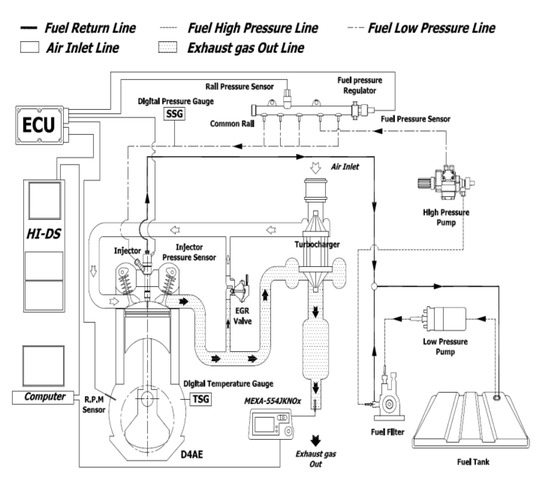
Figure 1.
Configuration of common rail diesel engine.

Table 1.
Specifications of common rail diesel engine.

Table 2.
Specifications of emission measurement devices.

Table 3.
Quality standard of diesel fuel, BD100 and BD20.
An EGR system is a kind of recycling device that is used to significantly reduce the NOx content of the engine exhaust. The NOx content rapidly increases when the combustion temperature exceeds 2000 °C, so it is necessary to maintain a low combustion temperature. The EGR system can decrease the combustion temperature during the combustion and expansion stroke by decreasing O2 concentration (dilution effect), increasing heat capacity with H2O and CO2 in exhaust gas composition (chemical effect), and reducing recirculated exhaust gas temperature by EGR cooler (thermal effect). This process reduces the amount of NOx emitted from the engine, remarkably. However, whereas EGR is effective for reducing NOx emission, it adversely affects the operation of the mixer and reduces engine performance, such as torque and power. It is, necessary to identify the segment of the driving cycle where NOx emission is high and apply the proper amount of exhaust gas recirculation.
2.2. Test Condition and Method
Diesel engine exhaust gas is mostly composed of N2, CO2, H2O, and unused engine intake air, which, together, constitute more than 95% of the emission from the exhaust pipe. More precisely, the composition of the exhaust is as follows: N2 (71%), CO2 (18.1%), H2O (9.2%), and several harmful components, including CO, HC, and NOx (1%). The regulated emission components of a diesel engine are the diesel particulate matter (DPM) and total particulate matter (TPM). The regulation is based on the mass content of NOx, HC, CO, and other materials in the PMs. In the present study, the HC, NOx, CO2, and CO contents of the test engine exhaust gas were analyzed with respect to the engine speed (780, 1000, 1500, 2000 and 2500 rpm). The number of injector holes was also varied as 5, 6, and 7, respectively (see Figure 2), to examine their effect on the engine performance. In addition, to determine the effect of biodiesel oil on exhaust gas, different mixture ratios were considered, namely, 0%, 10%, 20% and 30%. Finally, the composition of the exhaust gas with respect to the use or otherwise of an EGR system was examined.
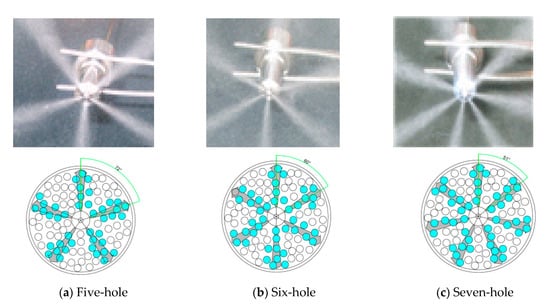
Figure 2.
Shapes of fuel injection using five-, six-, and seven-hole injectors, respectively.
When the exhaust gas recirculation device is installed to the diesel engine to suppress the creation of NOx, the combustion performance may decrease, due to the inflowing of the exhaust gas to the suction port of the engine. However, some portion of the remaining exhaust gas has a good effect on the conversion of energy to the combustion gas. To calculate the EGR gas amounts, ECU measures, and calculates the mass of the inflow fresh air in the engine by using the flow meter. Based on the ECU calculation, the EGR solenoid valve controls the mass flow rate of exhausted gas for re-circulation. Generally, the EGR solenoid valve is controlled by the pulse width modulation (PWM) method from ECU, and EGR valve opening is determined by the control value. The EGR rate can be calculated by Equation (1).
Table 4 gives the test conditions of the HSDI engine system. The engine operating status was not always constant, so the experiment was repeated under no-load condition more than 20 times for each set of variables, to maximize the credibility of the obtained data. Variables such as engine speed, fuel pressure, fuel pressure regulation, temperature of the cooling water, and fuel injection were constantly reset to maintain their values. The engine control unit regulated the fuel pressure; the basic control consisted of 5% opening of the EGR valve representing 0% of EGR rate. When EGR was used, EGR valve was controlled to maintain 20% of EGR rate for 1000 rpm, 1500 rpm, and 2000 rpm of engine speed. The experiment commenced when the temperature of the cooling water stabilized at 82 ± 2 °C after a sufficient warm-up period. The set experimental variables were the number of injector holes, the mixture ratio of the biodiesel oil, and the use or non-use of EGR. The detailed experimental conditions are presented in Table 5.

Table 4.
Test conditions (Coolant temperature: 82 ± 2 °C).

Table 5.
Experimental variables.
3. Result and Discussion
3.1. Effects of Injector Hole in Emissions
Figure 3 and Figure 4 represent the experimental results of emission characteristics with diesel fuel injector and without EGR conditions varying number of injector holes. Figure 3 shows the changes in the concentrations of HC and NOx, with respect to the number of injector holes under diesel fuel without EGR. At 780 rpm, using the five-hole injector, 28.8 ppm of HC was detected in the exhaust. The values were 21.4 and 20.6 ppm for the six- and seven-hole injectors, respectively, which represent reductions of 7.4 and 8.2 ppm, relative to the case of the five-hole injector. At 2500 rpm, the detected HC concentrations in the exhaust were 117.7, 42.4 and 35.4 ppm for the five-, six-, and seven-hole injectors, respectively. This indicated reductions of 63.4% and 69.8% when the number of injector holes was increased to six and seven, compared to the use of five holes. These results show that the HC emission is significantly reduced by using six and seven injector holes, compared to using five holes. When the number of injector holes was five, the injection shape of the fuel was not evenly distributed, and the size of the droplet was large. The temperature varied non-uniformly, with a significant difference in the wall surface of the cylinder, and incomplete combustion occurred for high-speed combustion. Concerning NOx, the emission concentrations at speeds of 1500 rpm and 2000 rpm were less when using a five-hole injector compared to using six- and seven-hole injectors. However, the concentrations were less for the six- and seven-hole injectors at other speeds. Specifically, the NOx emission concentrations for the five-, six-, and seven-hole injectors for an engine speed of 2500 rpm were 31.8, 21.6, and 22.4 ppm, respectively. This represented decreases of 10.2 and 9.4 ppm when the number of holes was changed to six and seven, respectively, relative to using five holes.

Figure 3.
HC and NOx emissions with respect to number of injector holes and engine speed.
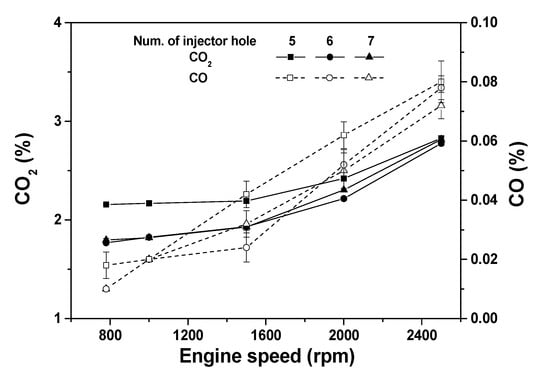
Figure 4.
CO2 and CO emissions with respect to number of injector holes and engine speed.
Figure 4 shows the measured CO2 and CO concentrations of the exhaust with respect to the number of injector holes under diesel fuel without EGR. The detected CO2 concentration for an engine speed of 780 rpm was 2.156% for five holes. The values were 1.768% and 1.796% for six and seven holes, respectively, which represent about 60% reduction compared to using five holes. The CO2 concentrations of the exhaust at an engine speed of 2500 rpm were 2.828%, 2.776%, and 2.816% for five, six, and seven injector holes, respectively, which represent changes of 0.012–0.052%. The CO2 exhaust performances at a speed of 780 rpm for six and seven injector holes were thus excellent, although there was a reduction in the progressive change, as the number of holes was increased from five. This confirms that the exhaust CO2 concentration depends on the spray shape of ejection. The effect on the fuel destitution according to the injector hole decreased, due to a high combustion speed as the engine speed increased, even though the combustion was not optimized. For engine speeds of 1500 rpm and 2000 rpm using six injector holes, the CO concentration decreased by 0.01% and 0.018%, respectively, relative to the case of five holes. The corresponding reductions in the case of seven holes were 0.01% and 0.012% for speeds of 1500 rpm and 2000 rpm, respectively. A 0.008% exhaust CO concentration was detected at a speed of 2500 rpm for a six-hole injector. It was also found that the reductions in the CO concentration for speeds of 1500 and 2000 rpm using a seven-hole injector were 0.01% and 0.012%, respectively, relative to using a five-hole injector. Furthermore, the measured CO concentration at a speed of 1500 rpm using a seven-hole injector was 0.08% higher than that for a six-hole injector. Overall, the effectiveness of the injector for reducing the HC, NOx, CO2, and CO concentrations of the engine exhaust was found to increase with an increasing number of holes. Since the spray angle of five-, six-, and seven-hole injector is 72°, 60°, and 52°, respectively, the contact area of fuel to air increases with an increasing number of injector holes. The combustion time decreases as the contact area between air and fuel increases. Therefore, it was confirmed that the combustion in the engine with many injector holes was ineffectual to complete combustion. In other words, among the three injectors considered in the present study, the seven-hole injector was found to be the best for reducing the harmful components of the exhaust gas produced from biodiesel fuel, with or without using the EGR system. It seems that an increase in the number of injector holes provides a better atomization of the liquid fuel enhancing mixing ratio between air and fuel under lean mixture conditions. This phenomenon can reduce the temperature rising rate and maximum in-cylinder temperature. Since NOx emission is a strong function of the temperature, the better atomization can reduce NOx emission. Carbon based emissions, HC, CO, and CO2, can be formed, due to the partially unmixed reaction zone under conventional non-premixed compression ignition engine. By increasing the number of injector holes, the improved mixing ratio results in a significant reduction of HC, CO, and CO2.
3.2. Effects of Biodiesel Composition on Emissions
Figure 5 and Figure 6 represent experimental results with a seven-hole injector and without EGR conditions varying biodiesel composition. Figure 5 shows the measured exhaust concentrations of HC and NOx, with respect to the ratio of the biodiesel oil that was mixed with pure diesel. As can be observed, the HC concentration decreased from a maximum of about 13–19.7% with an increasing biodiesel oil ratio. Biodiesel oil ratios of 20% and 30% actually produced almost the same HC exhaust concentrations, which were relatively low. The HC exhaust concentration for a speed of 2500 rpm was particularly low for 20% biodiesel oil. In the case of 2500 rpm, the HC concentration for the biodiesel oil ration of 30% was low. That means the effect on the decrease of HC at high-speed driving increased, as the mixing rate of biodiesel increased. The NOx concentration for a 1000 rpm using 10% and 20% biodiesel fuel was 6 and 4.4 ppm less than that for diesel, respectively. When the engine speed was 780 rpm, the NOx generation with 0% biodiesel was 84.5 ppm, and it was reduced by over 50% at the engine speed of 1000 rpm. This phenomenon occurred at all conditions, regardless of the contents of biodiesel.
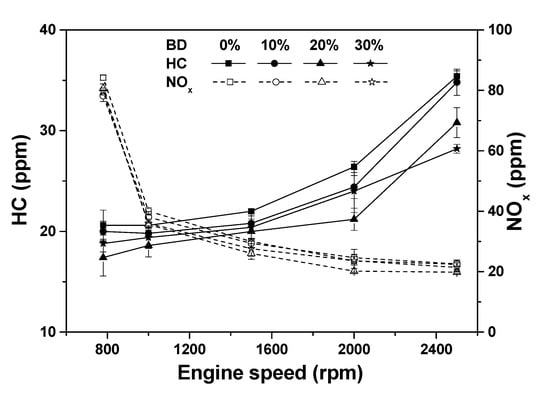
Figure 5.
HC and NOx emissions with respect to biodiesel oil ratio and engine speed.
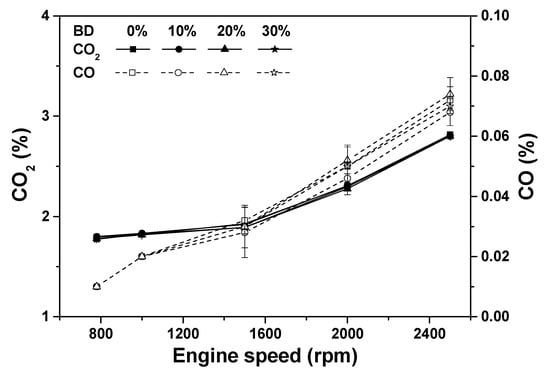
Figure 6.
CO2 and CO emissions with respect to biodiesel oil ratio and engine speed.
Figure 6 shows the CO2 and CO exhaust concentrations with respect to the ratio of biodiesel oil. Generally, regardless of the use of biodiesel ratio, the CO2 concentration between speeds of 780 and 1000 rpm appeared to be 0.036%, while it increased to 0.085% between 1000 and 1500 rpm, and to 0.388% between 1500 rpm and 2000 rpm, and finally to 0.508% between 2000 and 2500 rpm. The CO2 concentration was not affected by the mixing rate of biodiesel. That means the spray shape of injection and combustion efficiency did not change significantly when the biodiesel used as the fuel. However, the measured CO concentration at 780 rpm for 10% biodiesel oil was low, compared to that for 30% of the oil. A biodiesel oil ratio of up to 30% was thus found to be effective for reducing the HC, NOx, and CO2 exhaust concentrations. It can be confirmed that the CO concentration was not noticeably affected by the use of biodiesel. A ratio of 20% was found to be the most effective for reducing the total HC, NOx, content, specifically to within 10–19%. Generally, NOx emissions from the biodiesel engine increased, compared to NOx emissions from diesel engines. This is because biodiesel contains oxygen and is referred to as oxygenated fuel. However, this problem can be solved by applying a specific number of injector holes [26]. In this study, a seven-hole injector can cover and decouple the increase in NOx emissions from biodiesel. As a result, it can be found that the increase in the biodiesel oil ratio has a significant effect on the decrease in HC emissions.
3.3. Effects of EGR on Emissions
Figure 7 and Figure 8 represent experimental results with a seven-hole injector and a 20% biodiesel oil ratio with and without EGR. Figure 7 shows the HC and NOx exhaust concentrations with respect to the use or otherwise of EGR for a seven-hole injector and a 20% biodiesel oil ratio. The HC concentration was 17.4 ppm at an engine speed of 780 rpm without EGR, and 19.8 ppm with EGR, representing an increase of 2.4 ppm. In addition, when the engine speed increased from 1000 to 2000 rpm, the HC concentration for the use of EGR was 1.2–1.4 ppm higher than that for non-use of EGR. The HC concentration with EGR was thus about 8.8% higher than that without EGR. This was because, when EGR was employed, the valve was opened, and some of the exhaust gas re-mixed with the engine charge, resulting in a decreased combustion chamber temperature, which, in turn, caused incomplete combustion. Furthermore, due to the EGR portion in the cylinder, a relative amount of air should be decreased, resulting in an increasing share of biodiesel, which is as oxygenated fuel. As a result, increased oxygen composition in biodiesel caused more NOx formation with the EGR. Without EGR, the NOx exhaust concentration decreased by 75.4% (from 19.8 to 80.6 ppm) when the engine speed increased from 780 to 1500 rpm, while an 87.6% decrease accompanied in the use of EGR in the NOx concentration (from 79.2 to 9.8 ppm) for the same speed increase. However, there was a relatively small increase in the NOx concentration from 9.8 to 23.4 ppm when the engine speed increased from 1500 to 2500 rpm in use of the EGR. As with the use of EGR, the NOx concentration decreased by 19.3% on average for variable engine speed. This is because the EGR reduced the ratio of nitrogen and oxygen in the air at the combustion cylinder. However, the effect of EGR decreased with increasing engine speed. It is implied that different EGR rates have to be determined to reduce NOx emission at fixed engine speed and varying load conditions.
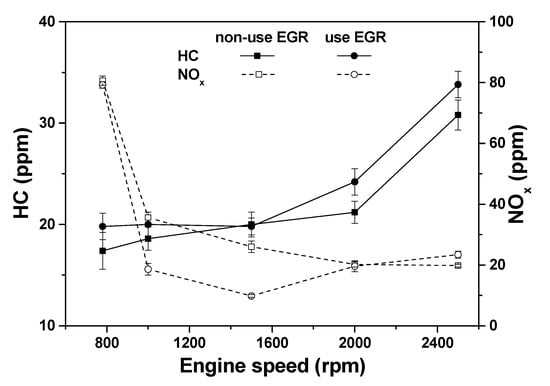
Figure 7.
HC and NOx emissions with respect to the engine speed and use/non-use of the exhaust gas recirculation (EGR) system.
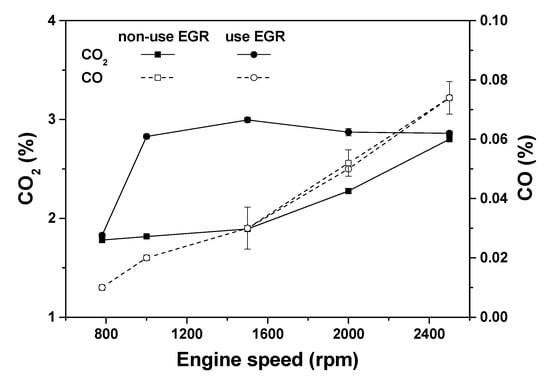
Figure 8.
CO2 and CO emissions with respect to engine speed and use/non-use of EGR system.
Figure 8 shows the CO2 and CO exhaust concentrations with respect to the use or otherwise of EGR for a seven-hole injector and 20% biodiesel oil ratio. The CO2 concentrations at an engine speed of 780 rpm for the use and non-use of EGR were 1.78% and 1.83%, respectively, which are comparable. However, the CO2 concentrations when using EGR were observed to be more significantly higher at speeds of 1000 rpm, 1500 rpm, and 2000 rpm. This was because part of the exhaust gas was recirculated into the combustion chamber, resulting in increased CO2 concentration compared to the case of fresh air intake. At the engine speed of 2500 rpm, the CO2 concentration was similar, regardless of the use EGR. This is because the EGR ratio was 5% when the engine speed was over 2500 rpm, which means that the EGR system did not operate at a high engine speed like 2500 rpm. At the high engine speed, the airflow rate and compression ratio are not enough to have a high combustion efficiency in case of use the recirculation of exhaust gas. Therefore, it is needed to control to stop the operation of EGR for high engine speed. It can be confirmed that it was effective to reduce the CO2 concentration to stop the operation of EGR, but the main purpose of using the EGR system is to decrease the NOx concentration, which is more harmful to the human body. The CO concentration was 0.01% at an engine speed of 780 rpm without using EGR, and it was 0.01% with EGR. At all engine speeds, the concentration of CO emissions depending on whether EGR is applied or not did not change significantly. The EGR system was thus found to be effective for reducing the NOx emission, but not for reducing the HC, CO2, and CO emissions. This confirms that the control of the amount of EGR can be used to optimize the reduction of NOx emissions.
4. Conclusions
In this study, the concentrations of HC, NOx, CO2, and CO in the exhaust gas of a common rail diesel engine were experimentally measured and analyzed concerning the number of holes in the fuel injector (five, six, and seven), the ratio of the biodiesel mixed with pure diesel (0%, 10%, 20% and 30%), and the use or non-use of an EGR system. Following is a summary of the findings of the study:
- (1)
- At an engine speed of 2500 rpm, the reductions in the HC emissions when using six- and seven-hole injectors were 77.6% and 132.4%, respectively, compared to using a five-hole injector. The corresponding reductions in the NOx emission were respectively 7% and 27%. In addition, at an engine speed of 780 rpm, the CO2 emissions when using six- and seven-hole injectors were 70% less than that for a five-hole injector. Six- and seven-hole injectors were found to be more effective for reducing the HC, NOx, CO2, and CO emissions compared to a five-hole injector, with the seven-hole injector being the most effective.
- (2)
- With regard to the biodiesel oil ratio, it was observed that the HC emission decreased by about 5–6% with increasing oil ratio. In addition, the NOx emission at an engine speed of 1000 rpm using 20% oil ratio was 4.4% less than that when using pure diesel. The use of biodiesel fuel was thus found to be effective for reducing the HC and NOx emissions, compared to the use of pure diesel, with 20% being the optimal mixture ratio of biodiesel oil. However, the CO and CO2 emissions were not significantly affected by the use of biodiesel fuel.
- (3)
- When using a seven-hole injector and a 20% biodiesel oil ratio, the application of EGR was found to reduce the NOx emission by more than 50%. However, the application of EGR produced differing results under different engine speed conditions. Moreover, while the EGR system was observed to be effective for reducing the NOx emission, this was not the case for the HC, CO2, and CO emissions.
Author Contributions
Conceptualization, H.C. and T.K.; methodology J.P.; validation, H.C., T.K. and J.P.; formal analysis, J.P.; investigation, T.K.; resources, H.C.; writing—original draft preparation, T.K. and J.P.; writing—review and editing, H.C.; supervision, H.C. All authors have read and agreed to the published version of the manuscript.
Funding
This research was supported by the Basic Science Research Program through the National Research Foundation of Korea (NRF) funded by the Ministry of Science, ICT & Future Planning (NRF-2020R1A2C2008248) and Human Resources Program in Energy Technology of the Korea Institute of Energy Technology Evaluation and Planning (KETEP), granted financial resources from the Ministry of Trade, Industry & Energy, Republic of Korea (No. 20194030202410).
Conflicts of Interest
The authors declare no conflict of interest.
Nomenclature
| A | area, m2 |
| BD | Bio-diesel |
| BTDC | Before top dead center |
| C | Carbon |
| CO | Carbon monoxide |
| CO2 | Carbon dioxide |
| CRDI | Common rail direct fuel injection |
| DME | Dimethyl Ether |
| DPF | Diesel particulate filter |
| DPM | Diesel particulate matter |
| ECU | Electronic control unit |
| EGR | Exhaust gas recirculation |
| H | Hydrogen |
| HC | Hydrocarbon |
| NOx | Nitrogen oxides |
| RPM | Revolutions per minute |
References
- Kim, J.H. Automotive Diesel Engine; Golden Bell: Seoul, Korea, 2018; ISBN 9788979716252. [Google Scholar]
- Kim, C.; Lee, K.; Park, J.; Baek, J. Influences of Injector Nozzle Shape on Nozzle Internal Flow and Outlet Characteristics. Trans. Korean Soc. Automot. Eng. 2013, 21, 108–116. [Google Scholar] [CrossRef]
- Wang, Y.; Lee, W.G.; Reitz, R.D.; Diwakar, R. Numerical Simulation of Diesel Sprays Using an Eulerian-Lagrangian Spray and Atomization (ELSA) Model Coupled with Nozzle Flow; SAE Technical Paper 2011–01–0386; SAE International: Warrendale, PA, USA, 2011. [Google Scholar] [CrossRef]
- Lee, S.; Lim, O. An Investigation on the Spray Characteristics of DME with Variation of Nozzle Holes Diameter using the Common Rail Fuel Injection System. Trans. Korean Soc. Automot. Eng. 2013, 21, 1–7. [Google Scholar] [CrossRef]
- Hong, J.G.; Ku, K.W.; Kim, J.H.; Lee, C.W. Spray characteristics of CRDi for injection and ambient pressure. KSAE 2012, 12, 56–60. [Google Scholar]
- Nayak, S.K.; Mishra, P.C.; Noor, M. Simultaneous reduction of nitric oxide and smoke opacity in TDI dual fuel engine fuelled with calophyllum-diesel blends and waste wood chip gas for modified inlet valve and injector nozzle geometry. Energy 2019, 189, 116238. [Google Scholar] [CrossRef]
- Yoon, S.; Lee, S.; Kwon, H.; Lee, J.; Park, S. Effects of the swirl ratio and injector hole number on the combustion and emission characteristics of a light duty diesel engine. Appl. Therm. Eng. 2018, 142, 68–78. [Google Scholar] [CrossRef]
- Dong, S.; Yang, C.; Ou, B.; Lu, H.; Cheng, X. Experimental investigation on the effects of nozzle-hole number on combustion and emission characteristics of ethanol/diesel dual-fuel engine. Fuel 2018, 217, 1–10. [Google Scholar] [CrossRef]
- Leach, F.; Ismail, R.; Davy, M. Engine-out emissions from a modern high speed diesel engine—The importance of Nozzle Tip Protrusion. Appl. Energy 2018, 226, 340–352. [Google Scholar] [CrossRef]
- Kim, J.-D.; Ainull, G.; Song, K.-K.; Jung, J.-Y.; Kim, H.-G. An Experimental Study on Spray Characteristics of Diesel and Bio-diesel Fuel. J. Korean Soc. Mar. Eng. 2011, 35, 53–59. [Google Scholar] [CrossRef]
- Ramadhas, A.S.; Jayaraj, S.; Muraleedharan, C. Characterization and effect of using rubber seed oil as fuel in the compression ignition engines. Renew. Energy 2005, 30, 795–803. [Google Scholar] [CrossRef]
- Suh, H.K.; Park, S.W.; Kwon, S.I.; Lee, C.S. Macroscopic behavior and automization characteristics of biodiesel fuels. Trans. Korean Soc. Automot. Eng. 2004, 12, 23–29. [Google Scholar]
- Yoon, S.H.; Park, S.; Kim, D.S.; Kwon, S.I.; Lee, C.S. Combustion and Emission Characteristics of Biodiesel Fuels in a Common-Rail Diesel Engine. In Proceedings of the ASME 2005 Internal Combustion Engine Division Fall Technical Conference (ICEF2005), Ottawa, ON, Canada, 11–14 September 2005; pp. 311–316. [Google Scholar] [CrossRef]
- Lim, J.; Cho, S. Effects of Fuel Injection Timing on Combustion Characteristics of Biodiesel Blend Oil in Diesel Engine. J. Korean Soc. Power Syst. Eng. 2012, 16, 10–15. [Google Scholar] [CrossRef]
- Sanli, A.; Yılmaz, I.T.; Gumus, M. Assessment of combustion and exhaust emissions in a common-rail diesel engine fueled with methane and hydrogen/methane mixtures under different compression ratio. Int. J. Hydrog. Energy 2020, 45, 3263–3283. [Google Scholar] [CrossRef]
- Somasundaram, D.; Elango, A.; Karthikeyan, S. Estimation of Carbon Credits of Fishing Boat Diesel Engine Running on Diesel-Ethanol-Bio-Diesel Blends with Nano Alumina Doped Ceria-Zirconia; Elsevier BV: Amsterdam, The Netherlands, 2020; pp. 1–6. [Google Scholar]
- Dubey, P.; Gupta, R. Influences of dual bio-fuel (Jatropha biodiesel and turpentine oil) on single cylinder variable compression ratio diesel engine. Renew. Energy 2018, 115, 1294–1302. [Google Scholar] [CrossRef]
- McCormick, R.L.; Tennant, C.J.; Hayes, R.R.; Black, S.; Ireland, J.; McDaniel, T.; Williams, A.; Frailey, M.; Sharp, C.A. Regulated Emissions from Biodiesel Tested in Heavy-Duty Engines Meeting 2004 Emission Standards. In Proceedings of the 2005 SAE Brasil Fuels & Lubricants Meeting, Rio de Janiero, Brazil, 11 May 2005. [Google Scholar]
- Agarwal, D.; Singh, S.K.; Agarwal, A.K. Effect of Exhaust Gas Recirculation (EGR) on performance, emissions, deposits and durability of a constant speed compression ignition engine. Appl. Energy 2011, 88, 2900–2907. [Google Scholar] [CrossRef]
- Herzog, P.L.; Bürgler, L.; Winklhofer, E.; Zelenka, P.; Cartellieri, W. NOx Reduction Strategies for DI Diesel Engines. J. Engines 1992, 101, 820–836. [Google Scholar] [CrossRef]
- Maiboom, A.; Tauzia, X.; Hétet, J.-F. Influence of high rates of supplemental cooled EGR on NOxand PM emissions of an automotive HSDI diesel engine using an LP EGR loop. Int. J. Energy Res. 2008, 32, 1383–1398. [Google Scholar] [CrossRef]
- Lázaro, J.L.; García-Bernad, J.L.; Pérez, C.; Galindo, J.; Climent, H.; Arnau, F.J. Cooled EGR Modulation: A Strategy to Meet EURO IV Emission Standards in Automotive DI Diesel Engines. In Proceedings of the SAE 2002 World Congress & Exhibition, Detroit, MI, USA, 4–7 March 2002. [Google Scholar]
- Koder, A.; Schwanzer, P.; Zacherl, F.; Rabl, H.-P.; Mayer, W.; Gruber, G.; Dotzer, T. Combustion and emission characteristics of a 2.2L common-rail diesel engine fueled with jatropha oil, soybean oil, and diesel fuel at various EGR-rates. Fuel 2018, 228, 23–29. [Google Scholar] [CrossRef]
- Jaliliantabar, F.; Ghobadian, B.; Carlucci, A.P.; Najafi, G.; Mamat, R.; Ficarella, A.; Strafella, L.; Santino, A.; De Domenico, S. A comprehensive study on the effect of pilot injection, EGR rate, IMEP and biodiesel characteristics on a CRDI diesel engine. Energy 2020, 194, 116860. [Google Scholar] [CrossRef]
- Park, G.T.; Lee, H.G.; Choi, J.S. Professional Engineer Transportation Vehicles; Sungandang: Paju, Korea, 2010; ISBN 13 9788931507720. [Google Scholar]
- Sayin, C.; Gumus, M.; Canakci, M. Influence of injector hole number on the performance and emissions of a DI diesel engine fueled with biodiesel–diesel fuel blends. Appl. Therm. Eng. 2013, 61, 121–128. [Google Scholar] [CrossRef]
© 2020 by the authors. Licensee MDPI, Basel, Switzerland. This article is an open access article distributed under the terms and conditions of the Creative Commons Attribution (CC BY) license (http://creativecommons.org/licenses/by/4.0/).